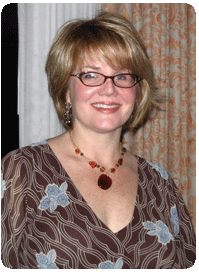Reading Room

Living History
Libba Bray is the best-selling author of The Gemma Doyle Trilogy, which includes A Great and Terrible Beauty, Rebel Angels, and most recently, The Sweet Far Thing. In the books, 16-year-old Gemma Doyle and her friends explore, break, and redefine the rules of friendship, family, love, magic, and what it means to be a girl in England during the turn of the 20th century. According to Libba, being a girl back then wasn’t all that different from being a girl today.
Girls Inc. Online spoke to Libba about why it was important to tell Gemma’s story through the lens of history—and the symbolism behind all those corsets she wears.
The Gemma Doyle Trilogy [ref. in intro above] takes place in Victorian England around the turn of the 20th century. What made you choose this time period?
I’ve always been interested in the Victorian era. I see a lot of cultural overlap between Victorian England and the Southern United States, and since I’m from the South, a lot of it resonates for me.
[I focused on] Victorian England, specifically. There was a woman [Queen Victoria of England] governing an empire, industrialization massively changing the society, and issues of class and race. I have always found myself drawn to the formal rules of the society as well as to the balls, dress, parading, and social calls. Then, [there was] the darkness of the London underbelly, and, well, what’s not to love, writing-wise? No wonder so many dark, twisted, Gothic-inspired tales feature this setting.
How would Gemma’s story be different if it took place today?
iPods. Definitely iPods. Even the Winterlands creatures would have them. And maybe a little Guitar Hero.
The girls would have more freedom than their Victorian counterparts do. I wouldn’t have had to spend insane amounts of time going, “Okay, how do I get them away from their chaperones so they can have this adventure?” They would have more options for their futures than being wives and mothers.
But, a lot of the emotional issues would still be the same for the girls today. The search for self, feelings of longing, hope, and loss—that stuff is universal.
What kind of research did you do to make sure your books’ historical details were accurate?
Well, I can tell you I have no desire ever to wear a corset. I have to give props to all the people who were willing to help me. I relied on the skills of librarians, scholars, and archivists. I have a bibliography on the Random House website, which lists all the books I consulted while writing the trilogy.
I did research at the British Library and the Transport Museum in London. Basically, I amassed a lot of little knowledge (a dangerous thing, I hear) which makes me a thudding bore at parties. The thing about research is that I always feel like I’m not doing enough. I could always do more.
What are some of the issues that Gemma and her friends deal with in 1895 that many girls still face today? What kind of advice would Gemma and her friends have for girls today?
Sadly, some of those issues haven’t changed much during the past 113 years. Certainly, a lot of the emotional [issues] in the novel [are] relevant because human beings are still human beings.
I’m sure there isn’t a teenage girl out there who hasn’t had to deal with the beauty industry, and being constantly bombarded with images, and how it all makes us feel about ourselves.
As for the advice Gemma and her friends would give? Be true to yourself and don’t be afraid to push back against those who would force you into some sort of safe, societal box. You don’t have to accept their limitations on you. You are free to break the paradigm (a.k.a. mold).
Gemma is constantly seeking relief from her corset; the character of Felicity longs to wear pants—clothing plays a big role in this trilogy. What do the details of your characters’ clothes symbolize?
All those layers and lacings and gloves and heavy bling… There is so much the girls have to “put on” in order to survive in their culture—a great deal of soft armor and ornamentation.
The clothes are symbolic of the weight of the expectations the culture places upon these girls. The corset is incredibly limiting and restrictive—it literally left women short of breath at times. That women usually had to be laced into them also symbolizes a sort of dependence.
Of all your characters, who is most like you? Which character would you most like to be like?
I always think that every character [a writer] creates is some facet (a.k.a. part) of [herself]—perhaps some part she doesn’t know about yet—but I probably identify most strongly with Gemma, some with Felicity, and some with the Gorgon. I don’t know that I’d want to be like just one character, but I think it would be fun to be Felicity for a day. And I’d like to borrow a little bit from [headmistress] Mrs. Nightwing. She’s about as solid, stiff-upper-lip as can be, and I came to admire the old, no-nonsense bird.
What are some personal lessons you learned while looking to the past to write?
That true change only comes about when people reject the illusions and demand the truth.
What's next?
Check out what else is in the Reading Room.
